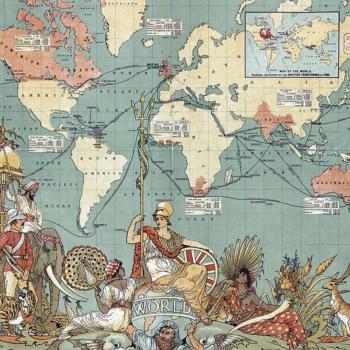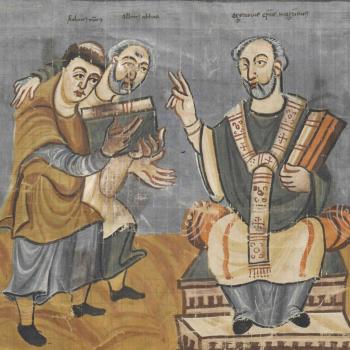I have been posting about declining fertility rates around the world, specifically about their impact on religiosity and secularization. Beyond that, those rates also serve as excellent indicators of trends in gender roles and relationships, and a wide range of social and cultural themes. Tell me a country’s total fertility rate (TFR) and I will tell you a lot about many other aspects of its society, and its religious life.
This is in no sense a Christian-Muslim divide. Intriguingly, some of the world’s fastest-falling fertility rates are actually in such Muslim countries as Iran, Tunisia and Algeria, and if that is true, the religious implications could be dramatic. In the next generation or so, will those countries experience a degree of European-style secularization?
Take Iran as a prime exhibit. From 1950 through 1980, Iran had an extraordinarily high fertility rate: the figure was seven children per woman through the 1950s, and still 6.5 in 1980. During the 1990s, however, the rate plummeted from 5.6 to 2.2, and as of 2015, the figure is around 1.7. In a few short years – basically, in the 1990s – Iran moved from a Third World population profile into First World conditions.
Iran’s demographic revolution has its roots in the era of the Shah, who was overthrown in 1979. Whatever its other failings, his regime struggled to modernize Iran, which meant enhancing the role of women, and reducing population growth. His policies promoted women’s education with a view to bringing more women into the work force, so that they would have less interest in raising large families. Initially, his policies had little effect, and they were soon reversed. After the Islamic Revolution, the government restricted access to abortion and closed the day care facilities that allowed women to work outside the home. These policies had some success during the Iran-Iraq war of the 1980s, when child-bearing was a patriotic duty, but the government resumed family planning efforts in 1993.
Iranian women resumed their progress towards social participation. In 1990, the rate of female participation in the labor force stood at a very low 22 percent, only a little higher than that found in Saudi Arabia and the Arabian Peninsular. But the Iranian participation rate grew to 33 percent by 2000 and 41 percent by 2005, in what the World Bank terms “a phenomenal catch-up”. Women in Iran today are far more likely to be in gainful employment than those of most nations of the Middle East or North Africa, and we see the consequences in the collapse in family size.
Low fertility transforms social and cultural attitudes, in ways that we have seen throughout southern Europe. Critically, such societies have broken the link between personal prosperity and the size of one’s extended clan, so that an individual must in the long run depend on the success of the wider society and state. People thus have an absolute investment in long-term stability. And as women no longer exist solely to provide the maximum number of descendants, they can seek autonomy and individual fulfillment. Marriage is a matter of choice, not obligation, and singleness becomes a valid option. If women do marry, they do so later in life, and consequently bear few children. Absent the automatic linkage between marriage and child-bearing, societies are much more open to contemplating alternative kinds of personal and sexual relationships, however much these arrangements violate traditional norms and prohibitions.
One generation of Iranians in 1985 launched human wave assaults against machine guns; their successors in 2025 will fight culture wars.
The dearth of children is very bad news for organized religion. Without abundant children, families have far less interest in supporting the formal religious teaching and collective participation designed to pass on traditional norms. If Iran is presently gay-free, as its former President famously assured us, the situation will be very different in another five or ten years. Low fertility does not of itself destroy religious practice, but it strongly encourages privatization, and woe betide those stubborn religious officials – priests, rabbis or mullahs – who try and enforce communal regulations.
Given another decade or so of uninterrupted progress, social trends make it very likely that Iran would move towards near-European conditions of stability and even, perhaps, political pluralism. Already, Iranians demonstrate levels of anti-clerical behavior that seem more appropriate to Catholic Europe a century ago. That’s one reason ordinary Iranians so often overwhelm visiting Americans with hospitality: if our lunatic mullah-led government says bad things against you, you must be fine people. After 9/11, Iran was the only Islamic country where there were spontaneous public demonstrations against terrorism, and expressing sympathy with the U.S.
That also explains why Iranians more recently have liked Bernie Sanders. As he is left-wing and socialist, they think, he must be strictly secularist. Our kind of guy!
With the exception of Iran, by far the sharpest fertility declines have been in the Maghrib countries most closely tied to Western Europe by migration, that is, Algeria, Morocco and Tunisia. I stress that the North African countries are not yet at European levels, but they are moving remarkably fast in that direction. (Tunisia just reached replacement levels). Conversely, the countries least tied to Europe, such as Iraq, Syria or Afghanistan, continue to have Third World profiles.
Just what is happening in the Maghrib countries? Everything depends on the changing attitudes and expectation of the women in these once highly traditional societies. Across the region, women have become increasingly involved in higher education, and have moreover moved into full-time employment. That sea-change simply makes it unthinkable for women to manage a rampaging tribe of seven or eight children. Often, too, images of women’s proper role in life have been upended by extended contacts with Europe. Migrants to France or Italy return home with changed attitudes, while families who stay at home find it hard to avoid the media portrayals of Western lives they see via cable and satellite dish. Maybe Europe and the Middle East are merging into one common Eurabia – but it’s far from clear which side is doing a better job of imposing its opinions on the other. Presently, it looks as if the Maghreb is becoming European.
Such a wrenching change cannot fail to have political implications. In a country with a Third World fertility rate, it is very unlikely that women will seek or be granted education: their designated career path as mothers is starkly clear. Meanwhile, adolescents and young men proliferate, and provide ample cannon fodder for armies or militias, to whom life is cheap. But then imagine a newer, more European society, in which men and women are intensely concerned about their nuclear families, and have invested their love and attention into just one or two offspring. As citizens become more educated, they are not prepared to accept the demagoguery and systematic corruption that has long passed for government in those regions. They see themselves as responsible members of a civil society, with aspirations that demand to be met: they feel they deserve full democratic participation. Of course the Arab Spring began in Tunisia, with its low fertility rate and its intimate ties to France.
Do read the excellent article here, on “Fertility Declining in the Middle East and North Africa.” It’s eye-opening.
Quite likely, demographic factors will create a two tier Muslim world, divided between regions of high fertility and high conflict (Pakistan, Iraq, Syria) versus such havens of relative tranquility and moderation as Iran and Algeria.
I submit that this is the most important single fact in the study of the contemporary Islamic world. And certainly the least reported.
ADDENDUM: An important addition here is David Goldman’s book, How Civilizations Die (And Why Islam Is Dying Too) (Regnery 2011).

















